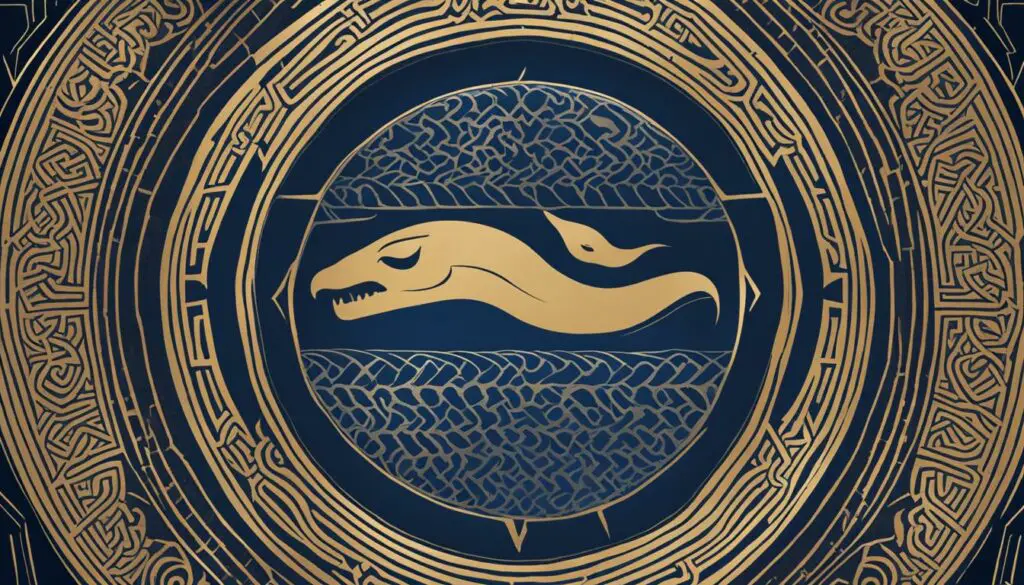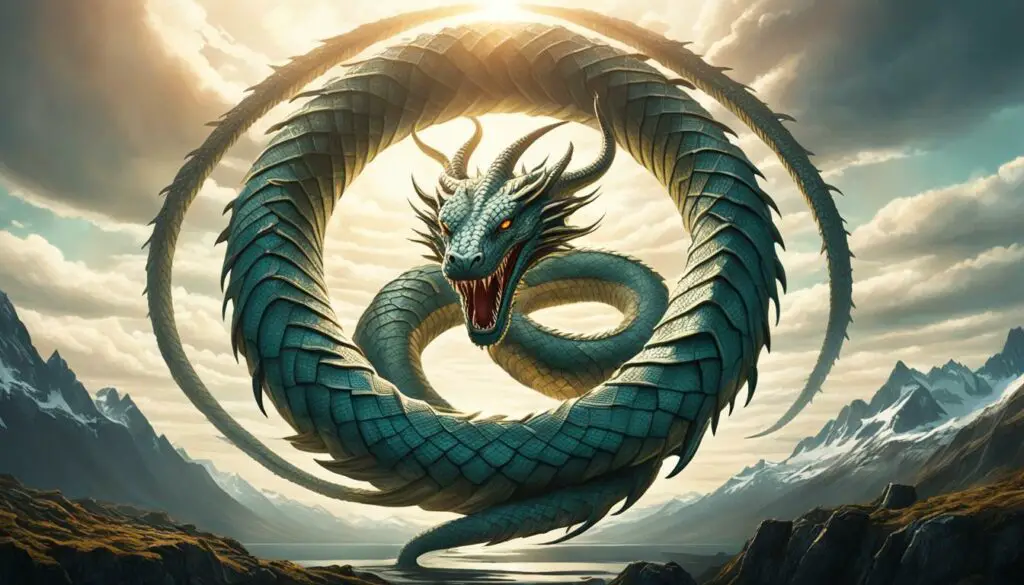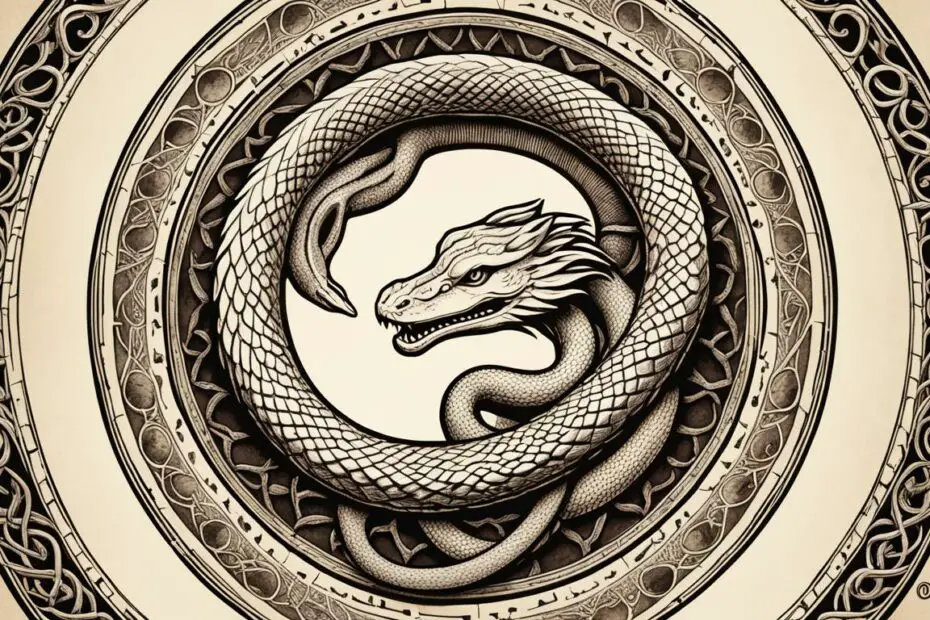The Ouroboros symbol is an ancient symbol that holds deep meaning and has captivated cultures around the world for centuries. With its origins shrouded in mystery, this symbol has appeared in various mythologies and traditions, serving as a powerful representation of the cyclical nature of life, death, and rebirth.
Derived from the Greek words “oura” meaning “tail” and “boros” meaning “devouring,” the Ouroboros symbol depicts a serpent or dragon biting its own tail, forming a circle. This imagery encapsulates the eternal cycle of creation and destruction, reflecting the unity of opposites and the interconnectedness of all things.
The symbol’s presence can be traced back to ancient civilizations, including Egypt, China, and Mesopotamia. In ancient Egypt, it was associated with funerary rituals, representing the journey of the soul through life, death, and the afterlife. In ancient Greece, it symbolized the celestial movements and the infinite cycles of nature. In Norse mythology, the Ouroboros took the form of the World Serpent, representing transformation and renewal.
Over time, the Ouroboros symbol has taken on various interpretations, adapting to different cultural contexts and belief systems. In alchemy, it embodies the union of opposites and the pursuit of spiritual and material perfection. Psychologist Carl Jung saw it as a symbol of self-reflection and self-transcendence, reflecting the continuous process of individuation and personal growth.
Today, the Ouroboros symbol continues to inspire contemplation and intrigue, inviting us to reflect on the profound mysteries of existence and our place within the cosmic order. Its enduring significance serves as a reminder of the timeless wisdom and universal truths that transcend cultures and generations.
Ouroboros Symbol in Ancient Egypt
In ancient Egypt, the Ouroboros symbol played a significant role in funerary rituals and beliefs, representing the cyclic nature of life, death, and rebirth. This ancient symbol appeared on various mediums such as tombs, sarcophagi, funeral papyri, rings, petroglyphs, and pottery, showcasing its prominence in Egyptian culture.
Ancient Egyptians had a profound understanding of the cyclic nature of time and saw the Ouroboros as a representation of divine cycles. The symbol’s circular shape, with a serpent or dragon devouring its own tail, emphasized the eternal and interconnected nature of existence.
The Ouroboros symbol can be found in a funerary text known as the Enigmatic Book of the Netherworld. In this sacred text, the Ouroboros serves as a powerful visual symbol that signifies the transition from day to night and from life to death. It represents the unified Solar-Osiris, combining elements of the sun deity and the god of the afterlife.
Example of Ouroboros Symbol in the Enigmatic Book of the Netherworld:
| Symbols | Meanings |
|---|---|
| Ouroboros | Representation of cyclic nature and the divine cycles of life, death, and rebirth |
| Serpent | Symbolic of eternity, regeneration, and interconnectedness |
| Osiris | Deity associated with the afterlife, resurrection, and regeneration |
Ancient Egyptians firmly believed in the existence of an afterlife and sought to ensure a successful transition for the deceased. The Ouroboros symbol, with its emphasis on cyclic nature and the eternal interconnectedness of life and death, played a crucial role in their funerary practices. It served as a reminder of the continuous cycles of existence and the promise of rebirth.
Ouroboros Symbol in Ancient Greece
In ancient Greece, the Ouroboros symbol was closely tied to the concept of the cyclic nature of celestial movements. Inspired by Egyptian mythologies, the Greeks observed the celestial bodies and their patterns across the sky, leading them to associate the Ouroboros with the perpetual renewal of the heavens. They believed that the stars, in their constant motion, appeared to devour themselves on one horizon and be reborn on the other.
The Ouroboros symbolizes the infinite cycle of nature, representing the interconnectedness of all things. It encapsulates the idea of regeneration, as natural processes repeat in a cyclical fashion. Just as the celestial movements in the sky seemingly devour and renew themselves, so too does life on Earth go through stages of growth, decay, and rebirth.
Ancient Greeks integrated the Ouroboros symbol into their artistic and philosophical expressions. It served as a reminder that everything is interconnected and part of a larger cosmic order. This understanding influenced various aspects of Greek culture, including religious beliefs, philosophical concepts, and artistic representations.

Ouroboros Symbol in Norse Mythology
In Norse mythology, the Ouroboros symbol takes the form of the World Serpent, known as Jörmungandr. This monstrous serpent is said to encircle the entire world, creating a continuous loop as it devours its own tail. Jörmungandr’s presence represents the idea of transformation and change, symbolizing the cyclical nature of existence.
According to Norse myth, Jörmungandr’s release of its grip on its own tail signals the onset of Ragnarök, the apocalyptic battle that marks the end of the world. This event holds the potential for renewal and the beginning of a new cosmic cycle.
The Ouroboros symbol’s association with Jörmungandr underscores the interconnectedness of creation, destruction, and rebirth in Norse mythology. It serves as a reminder of the transformative power that exists within the natural order of the universe.
The World Serpent: Jörmungandr

| Key Aspects | Symbolism |
|---|---|
| Monstrous serpent encircling the world | Representation of interconnectedness and continuity |
| Swallowing its own tail | Symbol of cyclical nature, transformation, and change |
| Release during Ragnarök | Signifies the end of the world and the potential for renewal |
Ouroboros Symbol in Alchemy and Modern Interpretations
The Ouroboros symbol has had significant importance in the realm of alchemy, where it holds deep spiritual meaning and represents the union of opposites. In alchemical traditions, it is seen as a powerful symbol of the search for spiritual and material perfection. The Ouroboros embodies the concept of eternal cycles and the interconnectedness of all things, reflecting the cyclical nature of life, death, and rebirth.
In modern times, the Ouroboros has been interpreted in various spiritual and psychological contexts. One notable figure who delved into the symbolism of the Ouroboros was Carl Jung, a renowned psychiatrist and founder of analytical psychology. Jung considered the Ouroboros as an archetypal image representing self-reflection and self-transcendence.
For Jung, the Ouroboros symbolizes the process of individuation, the journey towards wholeness and integration of the self. It serves as a reminder that true transformation and growth require embracing and exploring the depths of one’s own psyche. By embracing both light and shadow aspects, individuals can achieve a sense of balance and harmony.
The Ouroboros continues to captivate and inspire people to contemplate on the nature of existence and the interconnectedness of all things. Whether through alchemy, psychology, or personal reflection, the Ouroboros symbol remains a potent reminder of the eternal cycles of life and the ongoing quest for spiritual understanding and personal growth.
FAQ
Q: What is the Ouroboros symbol?
A: The Ouroboros symbol is an ancient symbol that represents a serpent or snake devouring its own tail. It is a symbolic representation of the cyclic nature of existence and eternity. The symbol has been found in various mythologies and cultures around the world.
Q: What is the meaning of the Ouroboros symbol?
A: The Ouroboros symbol holds different meanings in different traditions. It signifies time, the cosmos, death and rebirth, unity with nature, and the beginning and the end. It represents the infinite cycles of life, transformation, and the interconnectedness of all things.
Q: Where did the Ouroboros symbol originate?
A: The Ouroboros symbol likely originated in ancient Egypt, China, or Mesopotamia. It has been found in mythologies and cultures around the world, including Greek, Roman, Hindu, Siberian, Norse, African, and South American.
Q: How was the Ouroboros symbol used in ancient Egypt?
A: In ancient Egypt, the Ouroboros symbol was associated with funerary rituals and beliefs. It appeared on tombs, sarcophagi, funeral papyri, rings, petroglyphs, and pottery. Ancient Egyptians believed in the cyclic nature of time and used the Ouroboros to represent the divine cycles of life, death, and rebirth.
Q: How was the Ouroboros symbol used in ancient Greece?
A: In ancient Greece, the Ouroboros symbol was associated with the cyclic nature of celestial movements. The Greeks adapted the image of the coiled serpent from Egyptian mythologies. They believed that the movement of the stars across the sky made it appear as if the heavens devoured themselves on one horizon and renewed themselves on the other.
Q: What is the significance of the Ouroboros symbol in Norse mythology?
A: In Norse mythology, the Ouroboros symbol is represented by the World Serpent, Jörmungandr. Jörmungandr was a monstrous serpent that encircled the world and swallowed its own tail. It symbolized transformation and change. According to the myth, Jörmungandr would release its grip during Ragnarök, the apocalyptic battle, signifying the end of the world and the possibility of renewal.
Q: What does the Ouroboros symbol represent in alchemy and modern interpretations?
A: In alchemy, the Ouroboros symbol represents the union of opposites and the search for spiritual and material perfection. It is associated with the idea of eternal cycles and the interconnectedness of all things. In modern times, the symbol has been interpreted in various spiritual and psychological contexts, symbolizing self-reflection, self-transcendence, and contemplation on the nature of existence.
